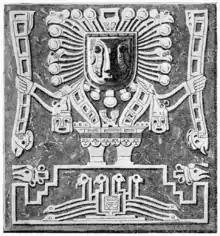Staff God
The Staff God is a major deity in Andean cultures. Usually pictured holding a staff in each hand, with fanged teeth and splayed and clawed feet, his other characteristics are unknown, although he is often pictured with snakes in his headdress or clothes. He is known as Viracocha in the Incan religion.

The oldest known depiction of the Staff God was found in 2003 on some broken gourd fragments in a burial site in the Pativilca River Valley (Norte Chico region) and carbon dated to 2250 BCE. This makes it the oldest image of a god to be found in the Americas.[1]
There are scholars who maintain that the Wari-Tiwanaku Staff God is the forerunner of the Incan principal gods, Sun, Moon, and Thunder.[2] As the chief deity, it was considered the creator god and served as the primary religious icon of the entire Peruvian Andes, particularly during the Early Horizon (900-200 B.C.) and beyond.[3] The worship of this deity spread to the Central Andes during the Middle Horizon (600-1000 A.D.)[4] This is supported by excavated Middle Horizon artifacts that resembled the Staff-God.[5]
Representations and iconography
The staff god was a basic iconography shared by the cultures of pre-Columbian Peru, particularly those occupying the northern coast and the southern highlands.[6] This is seen in the stylistic uniformity of the icons and representations, which suggested widespread adherence.[7]
There were varying depictions of the Staff-God among these Andean cultures. However, it was often portrayed as a deity in apotheosis, with hands always holding instruments of power.[8] For instance, an artifact found at Chavin de Huantar showed the deity holding a Spondylus and Strombus shells, which were female and male symbols, respectively. This representation indicated how the Staff-God wielded authority to maintain social harmony and the Andean ideal of gender complementarity.[3] Another Early Horizon sculpted stone, the Raimondi Stele, is perhaps the most popular representation and depicted the Staff-God as a sky or lightning god plunging down to earth.[9]
Representations of the southern highland staff god did not only carry motifs but were also presented with accompanying consorts in the form of deities painted on textiles used to decorate temple walls or ceramic vessels.[10]
The Staff God has one of the most important iconographical elements in central Andean archaeology and this is prominent in both portable and fixed art using different media such as stone, textile, and ceramic.[9] A form of the staff god, for example, takes a central role in the Sun Gate of the Tiwanaku culture, a single-stone monolith. Tunics and ceramics from both the Tiwanaku and Wari cultures of the Middle Horizon period showcase a similar god. Another example is the giant offering jars found at Qunchupata. They were painted with the Staff-God's image, one that bears resemblance to the god's depiction at the back of the Tiwanako's Ponce Monolith.[11]
| Wikimedia Commons has media related to Staff God. |
See also
Notes
- Hannah Hoag (15 April 2003). "Oldest evidence of Andean religion found". Nature. doi:10.1038/news030414-4.
- Isbell, William; Silverman, Helaine (2008). Andean Archaeology III: North and South. New York: Springer Science & Business Media. p. 307. ISBN 9780387757308.
- Henderson, Peter V. N. (2013). The Course of Andean History. Albuquerque: University of New Mexico Press. p. 16. ISBN 9780826353368.
- Eeckhout, Peter; Owens, Lawrence S. (2015). Funerary Practices and Models in the Ancient Andes. Cambridge, UK: Cambridge University Press. p. 137. ISBN 9781107059344.
- Salomon, Frank L. (2004). The Cord Keepers: Khipus and Cultural Life in a Peruvian Village. Durham: Duke University Press. p. 78. ISBN 9780822386179.
- Marcus, Joyce; Williams, Patrick Ryan (2009). Andean Civilization: A Tribute to Michael E. Moseley. Los Angeles, CA: The Costen Institute of Archaeology. p. 93. ISBN 9781931745543.
- Fagan (2012). The Oxford Companion to Archaeology. Oxford: Oxford University Press. p. 674. ISBN 9780195076189.
- Quilter, Jeffrey (2013). The Ancient Central Andes. Oxon: Routledge. p. 208. ISBN 9780415673099.
- Steele, Paul Richard; Allen, Catherine J. (2004). Handbook of Inca Mythology. Santa Barbara, CA: ABC-CLIO. pp. 243. ISBN 1576073548.
- Kleiner, Fred S. (2010). Gardner's Art through the Ages: Non-Western Perspectives, Thirteenth Edition. Boston, MA: Cengage Learning. p. 161. ISBN 9780495573678.
- Silverman, Helaine; Isbell, William (2008). Handbook of South American Archaeology. New York: Springer Science & Business Media. p. 736. ISBN 9780387752280.
External links
- New Scientist article on the find in Patavilca
- Archaeology magazine article, with photo and illustration of the Staff God
